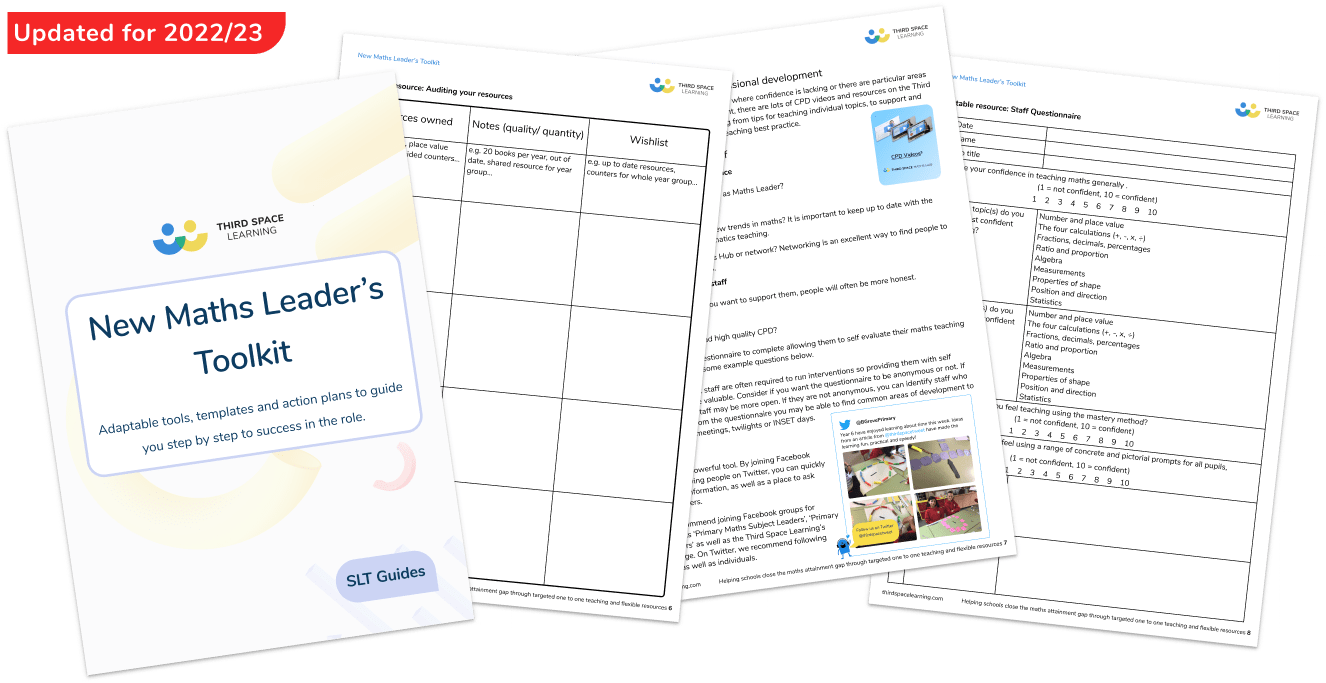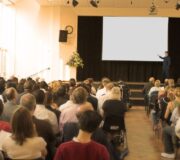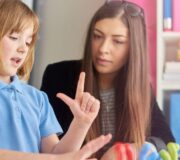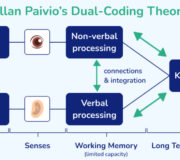A Teacher’s Guide To Spaced Repetition And Creating An Effective Spaced Repetition Schedule
Spaced repetition is a memory technique with a significant impact on classroom learning. This article introduces the concept of spaced repetition, examines how it complements other areas of educational research and provides practical advice for teachers to take advantage of the spacing effect.
What is spaced repetition?
Spaced repetition is the process of learning new material and reviewing it across multiple learning episodes to increase long-term retention. This prevents the need for re-learning or cramming before assessments. Experimental psychology shows that learning improves when students revisit and review new material over spaced intervals. This is often referred to as the spacing effect.
Why is spaced repetition an effective learning strategy?
Spaced repetition is an effective learning strategy because each time students recall information from long-term memory, it strengthens the neural connections associated with that piece of information. This means that subsequent retrieval will be easier and may eventually become automatic. Without recall, reinforcement, or review of information, we quickly forget.
Maths leader's toolkit
Adaptable tools, templates and action plans to guide you step by step to success in your maths leader role.
Download Free Now!Ebbinghaus’ forgetting curve
German psychologist Hermann Ebbinghaus discovered the forgetting curve in the 1880s through experiments on memorising nonsense syllables. He conducted learning and memory experiments on himself. Hermanndiscovered that soon after the learning of new information, these memories decay quickly. They then decay at a slower rate over time. His experiments demonstrate that people forget most newly learnt information unless it is reinforced.
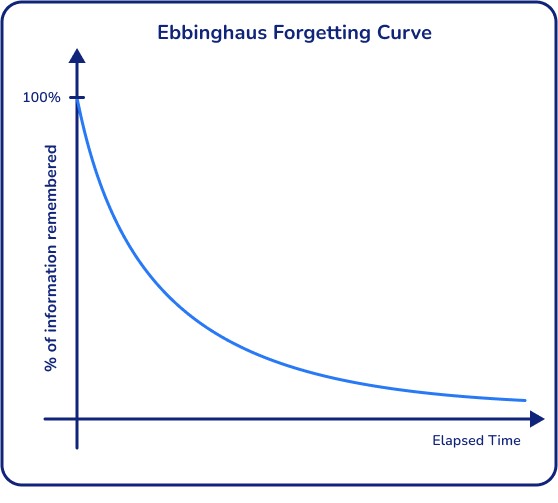
Spaced repetition addresses the forgetting curve
Spaced repetition research shows that the rate of decay decreases significantly when recalling, revisiting or reviewing information. This pattern continues for each subsequent revision session. Distributing the practice of new material for two weeks after initial learning and scheduling review sessions for one and two months after learning can help students remember almost all of the information.
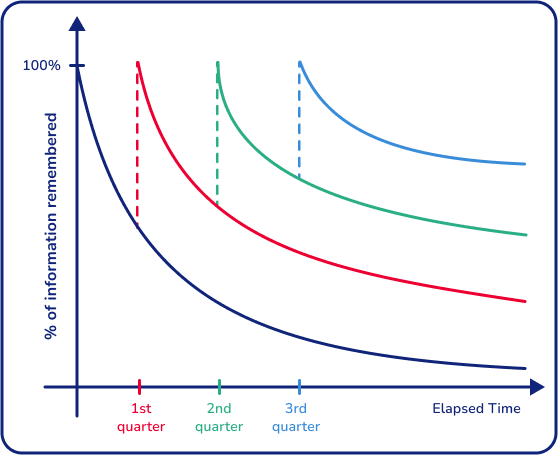
Classroom settings support the effectiveness of spaced repetition. The brain requires time to absorb and store information, making distributed learning more effective than massed practice.
For example, Rawson et al. (2013) found students whose revision of new vocabulary spread over several revision sessions performed better on a test immediately after studying and four weeks later compared to students who had the same revision time in a single session.

Meet Skye, the voice-based AI tutor making maths success possible for every student.
Built by teachers and maths experts, Skye uses the same pedagogy, curriculum and lesson structure as our traditional tutoring.
But, with more flexibility and a lower cost, schools can scale online maths tutoring to support every student who needs it.
Watch Skye in actionSpaced repetition techniques
Now that you understand the principle of spaced repetition and why it is effective, we will consider the learning techniques and teaching strategies that use spaced repetition.
Active recall
Active recall is the process of retrieving information from long-term memory in the absence of any cues. For example, a ‘filling in the blanks’ exercise is only an example of active recall if the list of missing words is not provided, and flashcards will only provide learners with active recall if they answer the questions (out loud or written down) before turning over the cards.
The process of active recall provides the level of desirable difficulty required to strengthen the neural connections and pathways to long-term memory. Spacing out opportunities for active recall is one of the most effective study methods that students can adopt.
Using entry/exit tickets for quick knowledge checks is an effective strategy in spaced repetition.
Leitner system
The Leitner system is commonly used to implement spaced repetition with flashcards. It is a simple system that organises flashcards into boxes or compartments based on how well a student has memorised or mastered the topic on each flashcard.
The compartments are ordered according to the amount of time required between the current retrieval and subsequent retrieval. Flashcards remembered perfectly move into the next compartment. This means there will be a longer interval between retrievals. Flashcards remembered less well remain in the same compartment, giving less time between retrievals. Incorrectly answered cards move to a compartment for more frequent review.
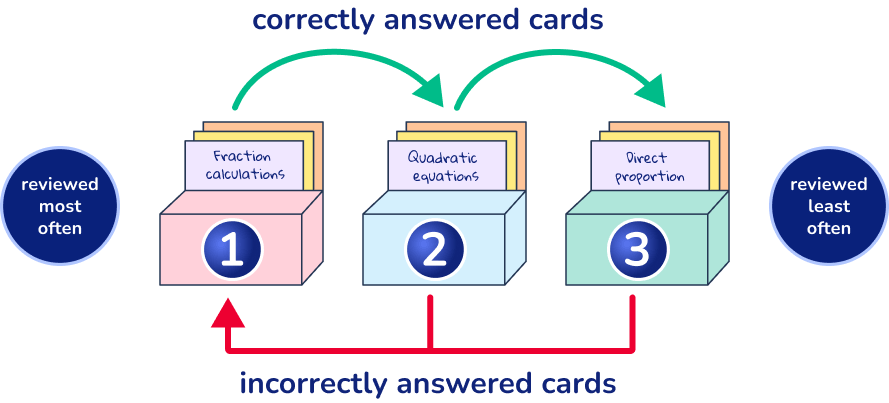
This approach is simple to implement and gives students autonomy over their spaced repetition learning. In addition to flashcards, this learning technique can apply to short times tables tests or past paper questions.
Flashcards are an effective tool for spaced repetition because they allow active recall in studying. When creating flashcards, focusing on quality over quantity by using small, manageable chunks of information is important.
Repetition schedules
It is important to consider how long the time intervals should be between retrieval attempts when designing a spaced repetition system (SRS). The intervals should be short after initial learning and then move to be as long as possible without compromising the learning process.
It is not practical for students to review all of their learning continually at short intervals; there must be a balance between workload and effectiveness. Many spaced repetition apps support students and teachers with this dilemma, including SuperMemo which arose from research conducted by Piotr Wozniak. This spaced repetition software calculates the optimal time intervals between retrieval attempts based on the learner’s previous performance and the complexity of the task.
Spaced repetition in the curriculum
Although spaced repetition is an effective independent revision strategy, spaced repetition works equally well when included in the course structure or syllabus.
For example, teachers could arrange for each homework to include questions from previously learnt topics so that students revisit each topic at least twice every term. The concept of a spiral curriculum is based on the spacing effect. Spiral curriculums review and revisit topics repeatedly throughout the year, building the level of complexity each time they revisit a topic.
When writing assessments, teachers can interleave previous topics in with the new ones. For example, the assessment may test area and perimeter, but present the lengths as fractions to revisit adding and multiplying fractions.
How to create an effective spaced repetition schedule
One of the simplest ways to create a spaced repetition schedule that will benefit all students in the class is to incorporate it into existing schemes of work.
Introduce each new topic into a ‘spaced repetition’ column in the scheme of work at the following time intervals relative to the initial teaching:
- One week
- Three weeks
- Six weeks
- Ten weeks
- Fourteen weeks
- Eighteen weeks
Add topics taught later in the year to the scheme of work for the following academic year. The spaced repetition column in a scheme of work will prompt teachers to review the previously learnt material in some format. They may do this through homework, a low-stakes quiz, or interleaving it with the week’s new topic.
Creating personalised spaced repetition schedules for students is much more time-consuming. After each retrieval attempt, schedules need adapting. Supporting students to use the Leitner system independently is an effective way to solve this problem. Alternatively, encourage them to use one of the many spaced repetition apps that are now readily available, such as Anki, Quizlet or Mathspace.
7 practical ideas for spaced repetition in the classroom
Using the following 7 practical ideas will help take advantage of the spacing effect in the classroom.
1. Creating and organising flashcards
This is particularly effective for language learning or subjects that require students to learn many key terms.
First, help students to create accurate flashcards and teach them how to revise using the cards for active recall. Once this is in place, students can start engaging in independent learning using the Leitner system; moving cards into the next compartment once they can accurately recall all the information on them. To help students stay on track with this, dedicate one maths homework per fortnight to testing themselves with their flashcards and moving the cards into the appropriate compartment.
Looking to support your GCSE students and their revision? Third Space Learning revision cards are an excellent revision resource for independent revision. Each card includes definitions and examples to help students review topics and identify areas for improvement.
2. Low-stakes quizzes
Use these at least once a week, or potentially in every lesson. They usually take five minutes to complete and a further five minutes to receive whole-class feedback.
A low-stakes quiz should not elicit any anxiety, which means there can be no consequence for getting a low score; students should understand that the purpose of the quiz is to improve learning.
Depending on the subject taught, a low-stakes quiz could be:
- A single question that requires a detailed response
- Five short-answer questions using mini whiteboards
- Spelling or times tables tests
- Writing out the definitions of keywords
It is an excellent way to revisit prior learning without taking too much time away from learning new content.
Explore Third Space Learning’s diagnostic assessments and multiple-choice quizzes for Years 1-6. Includes answers and helps to diagnose gaps and misconceptions.
3. Lesson starters
This could be a short activity that students do as they come into the classroom and settle down. You could use this time to have students complete a low-stakes quiz or a short test.
Alternatively, ask students to spend five minutes completing a ‘brain dump’ – writing down everything they can remember about a previous topic. For older students, an appropriate lesson starter could be a single past paper question.
For more ideas, explore Maths starters KS2.
4. Homework exercises
This is an excellent way to incorporate spaced repetition without taking any time away from covering new content.
Ideally, dedicate at least half of any homework assignment to prior learning. This approach enables students to revisit two or three previous topics every week. It is a good reminder to students that reviewing previous learning is an important part of how to learn maths.
5. Regular testing
If regular tests are part of your curriculum, include that week’s revision topics on the test, even if they are unrelated to the recently taught topics.
Students may find this slightly uncomfortable to begin with, but it will encourage them to continually review previously learned material. It also reinforces that learning does not stop at the end of a lesson or a sequence of lessons; it is an ongoing process.
6. Interleaving
This is the process of combining two or more topics into a single question. Interleaving is an effective teaching tool because it:
- allows students to revisit previous topics alongside learning new content
- adds desirable difficulty to the task
- encourages learners to compare the two topics and identify the features of each one
In a language lesson, it could be using previously learned sentence structures or word endings with a new set of vocabulary. In English, it could be comparing the lead characters from two novels. Used effectively, interleaving can enhance the learning of old and new material simultaneously.
7. Planning for spaced repetition in schemes of work
Without forward planning, it can be very difficult to revisit topics at regular intervals. Adapt schemes of work to include a reminder of which key topics to review each week. This ensures teachers revisit all topics at appropriate intervals.
Use any of the suggestions above for review. The most appropriate format depends on what else is taught that week, or whether there is a planned assessment.
Spaced repetition in maths
Spaced repetition is extremely effective and easy to implement in mathematics lessons and GCSE maths revision sessions. Many topics build upon previous knowledge, making interleaving a popular form of spaced repetition.
Lesson starters and low-stakes quizzes can strategically reactivate relevant prior knowledge before introducing a new concept.
Mathematics lessons constantly revisit mental maths, and schemes of work often follow a spiral curriculum, revisiting and building on topics year after year.
Third Space Learning’s one to one maths interventions build on students’ prior knowledge and strengthen the learning gaps students have. The low-stakes nature of the one to one maths sessions allows students to reactivate prior knowledge and build on previous concepts in a safe learning environment.

8 practical ideas for spaced repetition in maths
Below are eight examples of how you could incorporate spaced repetition through interleaving into mathematics lessons:
- Present lengths as fractions, surds or decimals when finding area and perimeter
- Use a mixture of cm and mm to interleave geometry questions with unit conversion
- Link finding the nth term with plotting the equation of a straight line
- Ask students to give their answers to percentage questions to multiple degrees of accuracy (e.g. 1 significant figure, 2 significant figures and 1 decimal place)
- Calculate percentages and fractions from bar charts
- Describe time using fractions of an hour for students to convert into minutes
- Remind students of BODMAS when finding the area of a trapezium or substituting into algebraic expressions
- Give test scores as fractions to convert into a percentage
Spaced repetition can have a significant impact on student learning and progress and contribute to creating a school culture of educational excellence. It is also an effective way to revise for GCSEs and other exams, avoiding cramming and the resulting stress and maths anxiety. However, it does require careful planning to successfully integrate it into classrooms and clear explanations and modelling from teachers to enable students to use it effectively during independent study sessions.
Read more: Dual Coding: A Teacher’s Guide To Help Improve Student Learning
Frequently asked questions
What is the science behind spaced repetition?
Cognitive science has shown that when information is moved from our short-term memory to our long-term memory it can remain there indefinitely if it is retrieved on a regular basis. Memories become more resistant to decay after multiple retrieval attempts, which means that the length of time between recalls can become increasingly longer.
What is an example of spaced repetition?
An example of spaced repetition in the classroom could be the following: first, new material is learnt in class, then it is reviewed in a lesson starter the next day, included in a low-stakes quiz the following week and a homework assignment the week after. After this, it is tested in an assessment two weeks after that.
What is the best spaced repetition schedule?
The best spaced repetition schedule will have retrieval opportunities placed soon after the topic has been taught for the first time, with subsequent retrieval opportunities being spread increasingly further apart. Most importantly, the schedule will be adaptive and only start to lengthen the time between retrievals once students have demonstrated mastery of the new topic.
DO YOU HAVE STUDENTS WHO NEED MORE SUPPORT IN MATHS?
Skye – our AI maths tutor built by teachers – gives students personalised one-to-one lessons that address learning gaps and build confidence.
Since 2013 we’ve taught over 2 million hours of maths lessons to more than 170,000 students to help them become fluent, able mathematicians.
Explore our AI maths tutoring or find out about school tutors for your school.



